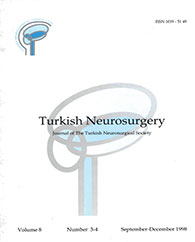Turkish Neurosurgery
1998 , Vol 8 , Num 3-4
1Osmangazi University Medical Faculty Departments of Neurosurgery, Eskişehir, Turkey
2Osmangazi University Medical Faculty Departments of Radiology, Eskişehir, Turkey
3Osmangazi University Medical Faculty Departments of Biostatistics, Eskişehir, Turkey A statistical comparison is made between neurological conditions and areas of lower lumbar spinal structures, as ascertained by CT-myelography, in patients with lumbar complaints. CT-myelography was taken of 38 patients with low back pain and/or radicular pain complaints, most of whom were suffering disc herniation. Measurements of cross-sectional area of spinal canal, dural sac, disc herniation beyond interspace (where appropriate) and ligamentum flavum were taken in 43 levels. These were levels L4-5 and L5-S1 lumbar disc hernia was assumed prediagnostically every case. The spinal reserve capacity area was calculated by substracting the rest from the spinal canal area. The ratio between spinal canal and dural sac area as well as that between spinal canal area and spinal reserve capacity were separately calculated for each level. These ratios were then examined for possible correlation with the neurological condition of the patients. Statistical analyses show the neurological condition of the patient to be in relation to reduction of spinal reserve capacity area rather than to reduction of dural sac area. This result is particular1y marked at the L5-S1 level. An evaluation of spinal reserve capacity is appropriate as an aid to investigations of clinical status, particularly of cases with lower lumbar complaints. Keywords : CT-myelography, herniated nucleus pulposus, spinal canal dimensions
Corresponding author : T. Erhan Coşan
2Osmangazi University Medical Faculty Departments of Radiology, Eskişehir, Turkey
3Osmangazi University Medical Faculty Departments of Biostatistics, Eskişehir, Turkey A statistical comparison is made between neurological conditions and areas of lower lumbar spinal structures, as ascertained by CT-myelography, in patients with lumbar complaints. CT-myelography was taken of 38 patients with low back pain and/or radicular pain complaints, most of whom were suffering disc herniation. Measurements of cross-sectional area of spinal canal, dural sac, disc herniation beyond interspace (where appropriate) and ligamentum flavum were taken in 43 levels. These were levels L4-5 and L5-S1 lumbar disc hernia was assumed prediagnostically every case. The spinal reserve capacity area was calculated by substracting the rest from the spinal canal area. The ratio between spinal canal and dural sac area as well as that between spinal canal area and spinal reserve capacity were separately calculated for each level. These ratios were then examined for possible correlation with the neurological condition of the patients. Statistical analyses show the neurological condition of the patient to be in relation to reduction of spinal reserve capacity area rather than to reduction of dural sac area. This result is particular1y marked at the L5-S1 level. An evaluation of spinal reserve capacity is appropriate as an aid to investigations of clinical status, particularly of cases with lower lumbar complaints. Keywords : CT-myelography, herniated nucleus pulposus, spinal canal dimensions





